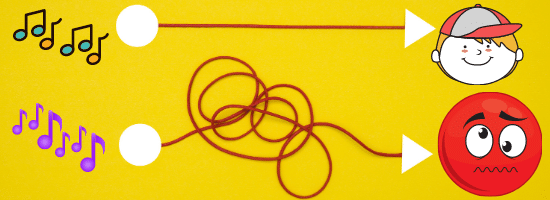
In this article, I will show you the best approach to ear training for the guitar. Most musicians consider ear training a boring and challenging process that takes the fun out of playing guitar. The key is to start simple and integrate it into your playing as you go along. Here are some things you can do to get started right away. You will begin to see results before you know it!
What Is Ear Training?

Ear training is essentially any process that teaches you to recognize characteristics of notes that you hear in music. It can be the relationship of one note to another or the overall sound of two or more notes played at once. We all do a certain amount of ear training as we listen to music, even if you are unaware of it.
Some musicians may rely more on ear training techniques than others. It can depend on many factors, including whether you play by ear, the type of instrument you play, and how many years you have played.
For example, if you play a fretted instrument like the guitar, it requires less finger accuracy to get the fretted note to sound in tune than a fretless instrument like a violin. With the violin, finger placement is more critical, and an experienced violinist can “hear” that the note sounds just right.
I played the violin when I was in fourth grade, and even at that age, I realized the importance of ear training. Several years later, Jimi Hendrix came along, and I bought a guitar as quickly as possible, but that is a story for another time.
You don’t even have to play an instrument. Just singing along with your favorite song uses ear training to stay in tune with the music. The more you do it, the better you sound.
Who Can Benefit From Ear Training For The Guitar?

Ear training is for anyone who would like to improve their ability to appreciate and perform music better. Here’s the thing about ear training that many people don’t really understand. Everyone does not require the same type and level of ear training.
It does not have to be the type of “all-out” training you would get at a music conservatory, where you would spend years or even an entire lifetime trying to perfect it.
The key is to identify how ear training can work best for you. As guitar players, we tend to train our musical ear as we go along, even if the process is unintentional. The better you get on your instrument, the more ear training you may require to continue to improve, and vice-versa.
So, it’s really up to you to decide if you even need formal ear training and how much you think you will require. If the whole concept is new to you, let me suggest that you try a little and see what you think.
How Ear Training For The Guitar Can Help You Play Better

We all tend to have strengths and weaknesses in our guitar playing ability. Therefore, one good approach to starting your ear training is to figure out what you need help with the most.
Here is some information that may help point you in the right direction. Ear training can help you:
- Determine what key a song is written in
- Play the melody of the song
- Identify the chords that make up the harmony of a song
- Create a solo that fits well the melody and harmony of a song
- Bend strings accurately to pitch
- Become a better songwriter
Choose 1 or 2 areas from this list or a list of your own that you want to focus on, and then start your training in one of the next sections’ levels. If you try to do too much at once, then it may become needlessly difficult and time-consuming.
Best Ways To Ear Train For The Guitar: The Three Levels Of Learning

There are many approaches to ear training, and you should choose the one that works best for you. The most important thing to consider is how long you have played guitar and how confident you feel with the instrument. Also, think about how you learn best and how quickly you are looking to progress. This will help you find the best method that will allow you to ear train efficiently and regularly.
If you are just beginning the guitar and feel overwhelmed with the instrument, adding an ear training regimen that is too difficult or time-consuming will probably be counterproductive and discourage you from successfully sticking with it. I have even seen people stop playing the guitar altogether, thinking that it is just not for them because they tried to learn too much too quickly!
Generally speaking, I usually suggest that players try to put themselves in one of these three skill levels. It will give you a good starting point and allow you to obtain a good mix of guitar playing and ear training.
Always remember to tune your guitar before playing it! You can either buy a digital guitar tuner or use a free online guitar tuner. Playing notes that are not in tune is the easiest way to hinder your ear training progress. If you are having a problem keeping your guitar in tune, see How To Keep An Electric Guitar In Tune.
Also, keep in mind that no matter how serious you may become about the guitar, there should always be an element of enjoyment and fun in the learning and performing process!

Level 1 – Ear Training For The Guitar: Beginners Start Here
This is the best place to start if everything about the guitar is brand new or you don’t have a lot of confidence yet in your playing ability. At this point, it’s important not to make your ear training the main focus of your practice time.
You are simply introducing it to help you become more attuned to the idea that you should listen carefully to everything you hear and play. Many beginners become so focused on finger placement mechanics and picking or learning to read music that they forget to listen to what’s actually coming out of their instrument!
To get yourself started in level 1 try one or both of the following ear training approaches.
Ear Training While Playing Your Guitar
The most natural way to begin your ear training is while you are playing your guitar. It helps you create a solid connection between your instrument and your ear. After a while, the very act of playing music will automatically kick you into careful listening mode!
The Basic Principle
Listen closely to all the sounds your guitar makes as you play. You will start to notice that each note has very obvious and also subtle differences in comparison to other notes.
The obvious sound differences will be in the relative pitch of one particular note compared to another. For example, the open E note on the 6th (thickest) string sounds much lower than the open E note on the first (thinnest) string. This is the pitch (frequency) difference between the two notes, which are two octaves apart.
Although this is quite easy to hear, there are also subtle differences in the “color” of any particular note compared to another. It’s like two different colors of blue that are just the slightest shade apart from each other. They each have a special visual characteristic that distinguishes them, and you may even like one shade better than the other.
At the beginning stage of ear training, these are very important principles to understand and practice, as rudimentary as they may seem. You will later see how they tie into relative and perfect pitch, but you should not concern yourself with this right now.

Try These Ear Training Exercises
Begin by playing single notes. The best starting point is to become familiar with the unique sound of each of the six open (unfretted) strings on your guitar. First, play these six notes while listening very carefully. Next, try to “sing” the note without sounding it and then play the note to see how close you came to matching its pitch.
You can also detune one of the six strings by unwinding or overwinding it a little (be careful not to break the string). Try to retune the string by using your ear and then check it for accuracy with a guitar tuner.
Repeat the same process using different single notes that you can play all over the guitar neck.
When you get comfortable with the sound of single notes, then listen carefully to the sounds of guitar chords, like the G chord that the woman is playing on her guitar in the image at the top of this article. Start with listening to the difference between different types of the same chord, like the difference between a G Major, G minor, and G Dominant 7th (G7th) chord.
Compare the sounds of different chords to each other, like the sound of the A, D, and G chords or A minor, D minor, and G minor.
Come up with your own ear training exercises as you continue to make progress.
Set A Time Frame And Keep It Simple
Do these exercises for 10 or 15 minutes each day during the course of your normal playing routine. Remember to listen carefully to the sound of everything you play or hear, even when you are not doing your ear training.
I recommend ear training on just the guitar, and preferably the same guitar. The same note at the same pitch (like the A note at a pitch of 440Hz) will have a bit of a different sound (timbre) on two different types of instruments (like a guitar compared to a piano).
Ear Training While Listening To Music Or Watching Music Videos
Whenever you listen to music, remember to listen carefully but not so much so that it ruins your enjoyment of the music itself. At first, just try to hear the basic difference between one sound and another. As your ear begins to improve, you will begin to distinguish repetitive sounds or patterns in the music.
One very helpful exercise you can do is to try to identify the sound of a particular note or chord in a song by ear and then match it to the actual sound on a chromatic pitch pipe to see how well you did. You can get a free pitch pipe app for your smartphone.
Don’t get stressed out if you have trouble at first or make mistakes. It’s all part of the learning process and the fun of learning to be a better musician.
Level 2 – You’ve Been Ear Training For The Guitar About A Year

This level is for those who have been playing for a while and can distinguish the basic differences in the sounds of single notes and chords by ear. You don’t need to be an expert, just comfortable with some of the techniques in level 1.
Level 2 adds the magic of computer technology to ear training to help you create a practice regimen that’s customized to your particular skill level and rate of progress. There are many types of free and paid computerized ear training programs available for every need and budget.
You can create a hybrid ear training program that incorporates elements from both level 1 and level 2. Still, I recommend that you start with only level 1 if you are a true beginning guitar player and have not had any prior musical experience playing a different instrument.
Ear Training Using An On-Line Ear Training Platform
There are basically two types of online ear training platforms. The first type is a program that takes you through all the various ear training techniques, presents you with exercises to complete, and then rates your performance to give you feedback on your progress.
The second type is a video-based platform like YouTube that presents you with ear training practice, theory, or both. This is more of a “do by seeing” (and hearing) approach. There are also online video courses that offer one-to-one instruction using programs like Zoom or Skype to connect you with teachers who specialize in ear training.
Each learning modality has its pros and cons. These platforms may offer more variety but less of an opportunity to practice your ear training on-demand or “on the go.”
Ear Training Using An App For your Laptop, Tablet, Or Smartphone
The other way to do computer-assisted ear training is by getting a free or paid app that can be used on your laptop, tablet, or smartphone. Typically these apps are more customizable than the average online training platform. If you use an app on your smartphone, then you can do some ear training whenever you have a few minutes to spare, no matter where you happen to be.
One product that I have personally used and enjoyed for many years is “EarMaster.” It runs on all platforms and allows you to sync your work across all your devices so you can use it on your Mac or PC laptop at home, and it will automatically update your tablet or smartphone. I will review this product in the future so stay tuned for that.
Here is a video on ear training that EarMaster promotes. Professional musicians and instructors speak about the importance of training your ear. It’s definitely worth having a look at.
You can use level 2 to improve your ability in one particular area of ear training or to take a more generalized approach; it’s all up to you!
Level 3 – You Feel Confident With What You Hear While Ear Training For The Guitar

Level 3 is primary for experienced guitar players who really want to up their ear training game. This type of training is popular among professional guitarists who want to play well in the most demanding of musical situations.
If you want to improvise complicated harmonic progressions and solos on-demand, this type of ear training will help you immensely.
Be aware that it requires a substantial time investment, mental discipline, a syllabus that effectively organizes the learning material, and keen attention to detail.
Don’t feel bad if you decide to move down to level 2. What’s most important is to keep the ear training experience positive and productive and to focus on the best fit for your particular musical needs.
Ear Training Classes And Music Schools
One of the best ways to effectively do level 3 training is to take an ear training course or enroll in a formal program. Level 2 computer-assisted ear training is particularly effective here as a supplement to class assignments and one-to-one training. Schools that offer a degree in musical performance typically have excellent ear training programs.
These days, some schools offer specialized degrees in guitar performance. The Berklee College Of Music and the guitar program at the Musician’s Institute are examples of schools with comprehensive guitar training with an emphasis on ear training.
Developing Relative And Perfect (Absolute) Pitch
The Development of relative and perfect (absolute) pitch usually takes years of practice and determination. These skills are usually not the best starting point for anyone just beginning ear training on their own.
Relative pitch is the ability to hear the distance in pitch (or the musical interval) between one note or chord and another. There is no question that anyone can master relative pitch with enough effort. Relative pitch can be quite useful when playing by ear and in musical composition. It gives you a “musical roadmap” of what to play next and makes finding the right notes of a song on your guitar a lot more intuitive.
Perfect (absolute) pitch is the ability to listen to a note or chord and identify it by name in any octave and on any instrument. It is a lot more difficult to master than relative pitch because you identify the notes themselves, not the relative distance or interval between one note and another. Perfect pitch essentially gives you the ability to recognize the notes’ names in a song as you hear it.
Many people believe that perfect pitch can not be taught but is a gift that you are born with. It took me about 10 years of daily practice to identify any note or chord with about 80 to 90% accuracy, so not “perfect” but pretty good. If perfect pitch ear training interests you then go for it.
The combination of relative pitch and perfect pitch (or some degree of perfect pitch) is usually the ultimate goal of ear training.
Many books, audio courses, and computer apps claim to teach the user perfect pitch with just a modest amount of effort and time investment. These products are usually based on false advertising.
How Long Does It Take To See Results?

After reading all this, do you really have to ask? It takes as long as it takes. Ear training is a near-ending process. Even if you set a very specific goal, you can always improve your skill level!
The other thing to realize is that different people learn at various rates and train using diverse techniques. What will make a difference is your level of interest, enthusiasm, and will to succeed. You don’t have to be passionate about your ear training, just committed and consistent in your approach.
I will say that, on average, after a year of continuous practice, you will begin to notice a significant improvement in the sound and composition of your music, especially if you play by ear.
The sooner you begin, the sooner you will reach your goal. You can waste years just thinking about doing it.
When I was young, I had a guitar teacher that was very disciplined and really no fun at all. What impressed me the most was the way he would tune my guitar by ear. I would check it with my pitch pipe (no digital guitar tuners back then) when I got home, and it would always be spot-on! It got so I would purposely put the guitar horribly out of tune to see if he could still do it, and he never let me down!
When I started to realize how good Jeff Beck was at microtonal bends, I became interested in ear training again. See my article on Jeff Beck’s Guitar Style – The Guitar Player’s Guitarist!
I wish I would have acted on my early interest in ear training, so I’m telling you to get yourself going, and you will begin to see results!
When And Where To Do Ear Training For The Guitar

Ear training can be done virtually anywhere and at any time of the day or night. Ideally, select a relatively fixed time slot to have your ear training sessions so that you will “fall into a routine.”
I prefer training early in the morning because I am mentally fresh and there are no distractions. I do some form of all three levels using my guitar, a computer program, and then a music video if time allows.
It’s important to keep consistency in your ear training schedule but feel free to add additional sessions as time allows. I’m always looking for opportunities throughout the day to add an extra training session, even if it’s only for a few minutes. This is where a smartphone app can really come in handy!
Analyzing an interesting song while listening to music in your car is another commonly used impromptu ear training method, but if you are the driver, please be sure to keep your eyes on the road.

Avoiding Common Ear Training Pitfalls
Here are some tips to help you avoid some of the common mistakes that players make during ear training. Remember these basic points, and things will go a lot smoother.
Choose Your Ear Training Level Wisely
Don’t try to bite off more than you can chew. It’s better to start at too low a level and move up than vice-versa. It takes time to train your ear. Learning how to hear the subtle differences between one note and another takes lots of patience, practice, and repetition. This is the foundation that you will build your ear training on, so make it a strong one!
Ditch The Anxiety When Ear Training For The Guitar
Try to relax as much as possible during an ear training session. If you make a mistake, realize that it’s part of the learning process. Learn to celebrate your progress and minimize your periods of discouragement. You will progress a lot faster if you approach your training with a positive attitude and make it an enjoyable experience.
If you find it difficult to control your anxiety and frustration, try taking a step back. Perhaps you tried to advance too quickly. Do not set a “carved-in-stone” advancement timeline; that’s not the way ear training works.
Break Up The Training Into Smaller Sessions
It’s better to do several ear training sessions throughout the day than a single really long one. Start with a fixed daily session of about 10 to 20minutes and add additional sessions as time allows you to do more. If you fatigue your ear, then the training will become counterproductive and needlessly frustrating.
Don’t Try To Rush Your Progress
Yes, I’m back to this again. That’s how important it is! Take your time and enjoy your ear training. Setting unrealistic goals or trying to compete with someone else’s progress is always a mistake.
Rushing the training is the second most common reason why people fail (the first is starting at too high a level). Mix your ear training into the music you enjoy playing. The idea is to work hard but at your own pace and to have fun in the process!
Always Keep An Open Mind
Keep an open mind and be ready to modify your ear training program as the need arises. If you encounter a point in your training that opens a new musical door for you, then don’t be afraid to explore it. Remember, ear training is there to help support your musical evolution, so be ready to use it accordingly.
It’s important to approach ear training as mostly an art but also a little like a science. Use your musical talent and intuition but always be methodical in your training.

Final Thoughts On Ear Training For The Guitar
Ear training for the guitar is a skill that will help you no matter what type of music you play or how long you have been playing. Many guitarists dread the idea of ear training because of someone else’s bad experience or their own perception that they are unlikely to succeed.
Don’t be afraid just to jump right in and get yourself going! If you had tried it before and did not succeed, try it again using some of the article’s suggestions.
To succeed with ear training, the most important thing is to find the right starting level and not rush your progress. Approach it in a determined but realistic manner and make it a positive part of your guitar playing experience.
You are never too young or too old to begin ear training. Music is a type of language all its own, so the younger you are, the easier it is to comprehend. If you have children, consider training their ear at the earliest possible moment. The sooner you begin, the more years of musical enrichment you will experience.
Think about using an online or app-based ear training resource to assist you in organizing your practice and analyzing your progress. Earning a degree in guitar performance can be an invaluable opportunity for experienced guitar players that want to take their playing to a professional level.
What To Read Next ➡ How To Overcome Guitar Playing Plateaus: Master Your Frets!

Tell Us What You Think
Please leave a comment below if you enjoyed this article on ear training for the guitar or wish to add additional information.
If you have any questions about ear training, I will be happy to try to answer them for you.
- Are you thinking about trying ear training, & if so, what’s stopping you?
- What has been your experience with ear training, good, bad, or indifferent?
- Any ear training tips to share, and how have they helped you?
- DO you have any particular ear training exercises that were a game-changer?




Hi, I’ve just gone through this amazing post you’ve shared about ear training for the guitar. Little did I know that ear training is the process that teaches you to recognize characteristics of notes that you hear in music like you clearly stated. What even caught most of my attention in this article is the fact that you’ve even provided the links where beginners like me can start for ear training and I’m definitely going to attend the training to have knowledge about how to play guitars because it’s my long time dream. Thanks for sharing this helpful information and I’ll also share your post too to help others.
Hi Kokontala,
Thank You for your comments!
I’m glad I was able to introduce you to the concept of ear training! Please give it a try and see what you think.
I really appreciate that you plan on sharing this article with others! Let me know if I can answer any questions for you.
Frank
When we’re just starting with the guitar, we’re overwhelmed. There are so many things to learn. I tend to pay more attention to where I place my fingers than to the sounds coming out of my guitar. And reading your post, I have discovered it’s a mistake. I will start to incorporate ten minutes of ear training into my practice sessions. Thanks for your timely advice.
Hi Paolo,
Thanks for your comments!
You’re doing just great, no mistakes! It’s natural to focus all your attention on playing mechanics when you are just starting. I did the same thing. I love that you’re adding 10 minutes of ear training to each practice session! Come back and leave me a comment update in about three months. I’ll bet that a whole new musical world will open up for you!
Frank
This is a fascinating post. I thought playing by ear etc was something that you were born with and not something you could learn. I am therefore very interested in how you advice readers to start slowly and build up. This is definitely something that music teachers should introduce at the very beginning and encourage.
I think that this is excellent not just for helping the learning process of playing the instrument, but is excellent just for appreciation of music in general.
I will definitely be more aware and listen closer to the actual music in future. This has taught me that I need to feel the music and not just listen to it.
Thanks very much for this useful and exciting information.
Keep up the good work.
Hi Geoff,
Thank You for your comments!
I’m happy to hear that this information has been enlightening to you! Yes, you are correct in saying that ear training can benefit the listener as much as the player.
Try some of the techniques in this article and see what you think. You may end up learning to play an instrument and that would be wonderful!
Frank
This is an eye-opening post! I come from a family of musicians (although I am not one) and I always thought the ability to play “by ear” was a talent one either had or didn’t have. Interesting. I guess the ones who didn’t have the ability just didn’t bother to learn. 😉
Hi Cynthia,
Thank You for your comments!
It sounds like musical talent definitely runs in your family so I’ll bet that you could be an excellent musician! Why don’t you pick an instrument you like and give it a try?
I took less than one month of guitar lessons and then slowly learned how to play my favorite songs by ear. It never even occurred to me that I couldn’t do it. I added the technical stuff like music theory many years later.
Everyone has the ability to play an instrument, you need to get past the learning curve. It will make your life better in ways that you never thought possible!
Frank